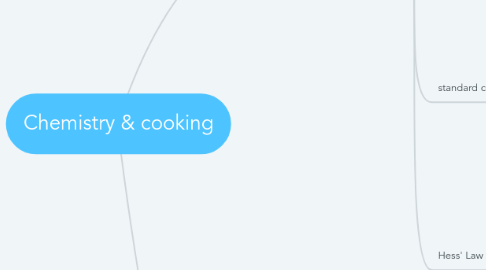
1. Enthalpy
1.1. Type of Enthalpy Changes
1.1.1. Exothermic (Heat Change Negative)
1.1.2. Endothermic (Heat Change Positive)
1.2. enthalpy equation
1.2.1. Q=m.C.DeltaT
1.2.1.1. Q=enthalpy/internal energy
1.2.1.1.1. kj/mol
1.2.1.2. m= mass
1.2.1.2.1. kg
1.2.1.3. c= specified heat capacity kj/kg.celcius
1.2.1.4. DeltaT= difference in temperature
1.2.1.4.1. final - initial
1.2.1.4.2. kelvin or celcius
1.3. calculating enthalpy
1.3.1. energy cycle
1.3.1.1. calculating unknown enthalpy change from a known enthalpy change of other reactions
1.3.1.2. for visual understanding you can refer pearson pg 225 - 229 (this platform won't allow me to upload photos)
1.3.2. bond enthalpies
1.3.2.1. bonds breaking
1.3.2.1.1. endothermic process
1.3.2.2. making bonds
1.3.2.2.1. exothermic process
1.3.2.3. H= n(sum of the bonds broken) - m(sum of the bonds formed)
1.3.2.3.1. n&m= the number of moles
1.3.2.3.2. (of the average bond enthalpy)
1.3.2.3.3. average bond enthalpy can be found in the data booklet pg 11
1.3.2.3.4. kj/mol
1.4. standard conditions for enthalpy
1.4.1. pressure 100 kPa
1.4.2. concentration 1 mol dm-3 for all solutions
1.4.3. all substances in their standard states
1.5. Hess' Law
1.5.1. A -> B -> C = A -> C
1.5.2. states that the enthalpy change for any chemical reaction is independent of its route
1.5.2.1. provided that these are the same
1.5.2.1.1. starting and finishing conditions
1.5.2.1.2. reactants and products
1.5.3. reversing the direction of the reaction reverses the sign of delta H
1.5.4. standard enthalpy change of formation
1.5.4.1. standard enthalpy change of formation of an element in its most stable form is zero
1.5.4.1.1. no chemical change so no enthalpy change when an element is formed from itself
1.5.4.2. ∆H (reaction) = ∑∆H (products) – ∑∆H (reactants)
2. Rate of reactions
2.1. Speed at which a chemical reaction happens
2.2. Factor of change in rate of reaction
2.2.1. Temperatrue
2.2.1.1. Maxwell Boltzmann distribution curve
2.2.1.2. Temperature increase
2.2.1.2.1. Average kinetic energy increase
2.2.1.3. Temperature decrease
2.2.1.3.1. Average kinetic energy decrease
2.2.2. Concentration of the reactants
2.2.2.1. Increase concentration
2.2.2.1.1. more number of particle
2.2.2.2. Decrease concentration
2.2.2.2.1. less number of particle
2.2.3. Surface area
2.2.4. Pressure
2.2.4.1. Ideal Gas Law
2.2.4.1.1. As the pressure increase, the volume decrease
2.2.4.2. Decreasing the volume will make the particles more concentrated
2.2.4.3. Less room for the particles to move, resulting in more collisions
2.2.4.3.1. Increases the rate of reaction
2.2.4.4. Haber's process
2.2.5. Catalyst
